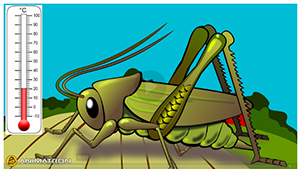Investigation: How Does Temperature and Humidity Affect Cricket Chirps?

This handout is intended to be a supplmental material for the cricket simulation. Instructors can print this for students instead of students creating their own data tables.
Introduction:
Crickets “chirp” by rubbing their wings or legs over each other. This phenomenon is known as stridulation. It is a means by which male crickets “call” to females to communicate their interest in mating.
Frequency refers to the number of chirps that crickets produce during a period of time. Some have suggested that you can tell the temperature and the humidity based on how fast crickets chirp.
Since it may be difficult to gather data on cricket chirps, since they most likely produce sounds at dusk, this simulation can be used to determine which variable, temperature or humidity, has the greatest effect on chirp frequency.
1. Develop a hypothesis (circle):
As the temperature increases, the frequency of chirping [increases / decreases / stays the same ]
As the humidity increases, the frequency of chirping [increases / decreases / stays the same ]
2. Data Table
Temperature Humidity Number of Chirps
3. Analyze the data you have gathered to answer the following questions in complete and coherent sentences.
a) How does temperature affect the number of chirps?
b) How does humidity affect the number of chirps?
c) Identify the independent (experimental) variable in this experiment.
d) Identify the dependent (responding) variable in this experiment.
e) Suggest another experiment that could be performed on crickets and chirping.
f) Why should you only use male crickets in these experiments?